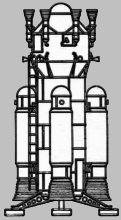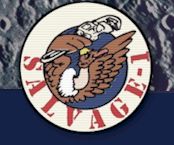|
|
The Vulture
The
Vulture was literally made of junk. Harry Broderick and his team
assembled an unorthodox moonship out of old NASA equipment and whatever
they had laying around at the time. The main body was once a Texaco gasoline
truck. The capsule was a cement mixer. The landing feet were recycled
tires. The main engines came from NASA surplus Agena D upper stage boosters.
Harry's team of
ex-engineers built a ship about one tenth the size of rockets used by
NASA that relied on a powerful fuel called mono-hydrazine to get up and
go. Though it provided the power necessary for such a small ship to
reach the moon, mono-hydrazine was extremely unstable above 150 degrees
F. The solution was to build a cooling system into the main tank,
making it in effect a large flying refrigerator.
Its real ingenuity lay
in the fact that as fuel was burned during the flight, the accordian
tank drew up within the main body, leaving plenty of cargo space at the
bottom of the ship for stowing salvaged items. Guidance for the Vulture
was provided via a radio link with ground computers, which were either
hacked into or accepted as a courtesy from NASA.
Computer guidance was
crucial during liftoff and landing because a human pilot could not keep
track of the ship's systems, the engine controls and the ship's
trajectory all at the same time. Lunar trajectory is a complicated
thing to calculate, even for a simple spaceship made of junk.After the
moonflight, the Vulture was converted for conventional fuel and in
order to satisfy FAA requirements was given the registration name
"Experimental Hover Machine Salvage-1".
 |
Vulture Specifications:
|
| Height: |
33' 6" |
| Diameter: |
Capsule: 9'
Tank: 7' 6" |
| Fuel: |
Mono-Hydrazine
(unstable
above 150 degrees F) |
| Fuel Capacity: |
1000 gallons |
| Weight: |
5 tons empty |
| Crew Capacity: |
2 (later
modified for 3) |
|
|




